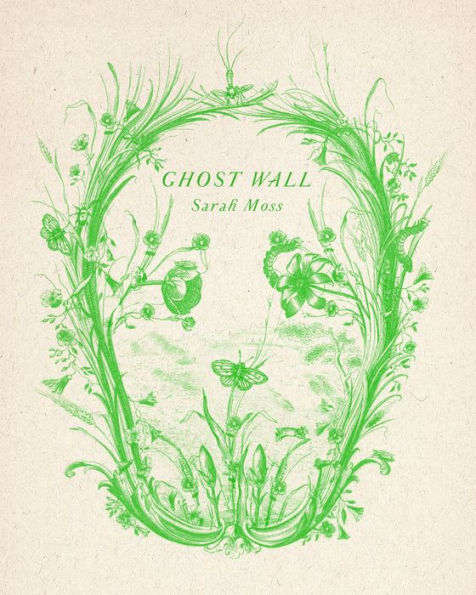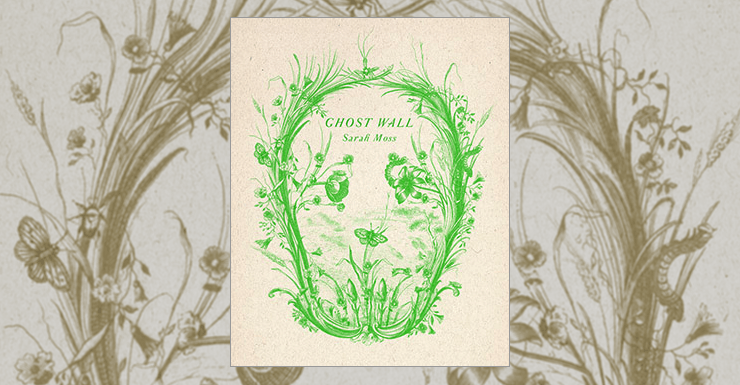I spent a long time in grad school learning the word reify. I don’t know why it was so hard for me, but the definition just wouldn’t stick: reify, to take an abstract concept and give it form.
Sarah Moss’ Ghost Wall is in a way, about reification. The crux of the book is that a group of modern, mid-1990s people—an Anthropology professor, his three students, a bus driver, his wife, and his daughter—take something they see as a symbol, the “Ghost Wall” used by Iron Age Britons to magically defend their territory, and they make it real. They build it. They commit to the destruction necessary to procure animal skulls, they commit to the construction of gathering wood and putting up the wall. But they don’t put much thought into the symbolic aspect. What is a wall for if not to keep people out, or to fence people in? Who or what are you trying to keep out? The walls were used to be real, and have a specific purpose, but as time passed they became symbols in the minds of modern people. By making them real again the characters are giving form to the fears and beliefs of their ancestors—fears and beliefs that have no place in a modern world.
I’ll admit this was a hard read for me. I absolutely hate reading scenes of violence against women. I hate stories in which women are trapped by brutal men. And yet, I also know that these stories, as long as they continue playing out in life, are necessary to tell. I know that at times they’re the only way to tell a particular type of story. Such is the case in Ghost Wall. The story is exquisitely written; the characters are perfectly drawn and pop off the page into my head.
And I wish I could murder one of the characters with my hands.
Ghost Wall could also be read as an example of “Folk Horror,”—a subgenre of horror particularly popular in 1960s British film that draws on the pagan rituals, human sacrifice, and witchlore of England’s past. But what makes it great is that Sarah Moss leads us onto the muddy, bloodstained road that Folk Horror normally follows, and then finds side paths and valleys and hills that take us in very different directions.
Seventeen-year-old Silvie, her Mum, and her Dad join an anthropology class living in the far North of England in what is supposed to be an experiment in Iron Age living. There’s Professor (who gave a lecture on human sacrifice called “Using Your Heads”) and his students Molly, Dan, and Pete, who are game but also occasionally nip off to Spars for chocolate and Cokes. The Professor has studied primeval Briton for decades, and is an expert on theory. Silvie’s dad, a hobbyist, spends his weekends and vacations living as much like the “bog people” as possible. We soon learn that he’s indoctrinated Silvie, teaching her about the Bog People and their penchant for human sacrifice for many years—as on a trip to a museum to see a the remains of an Iron Age man when she’s a small child:
I knew about the peat bogs up on the moor, yes, the ones where the cotton flags grew, where we had to jump from tussock to tussock not to fall in the mire? Even then, when I must have slowed him down enough to be annoying, he took me walking up there every Sunday, whatever the weather; yes, I knew. Right, well, those bogs have always been special places for folk round here, right back in ancient times, people saw the marshlights, probably, thought it was spirits or summat like, and probably they were frightened to fall in just like us because I knew, didn’t I, that the bog could hold you down and suck you in, he’d told me, hadn’t he, how hard it could be to get out. Aye, I said, yes. We were crossing the moor by then, the wires swooping along the tracks, and it was a clear-enough grey day but I couldn’t see any bog, just heather and sheep and below us terraced houses like our own creeping up the hillside. Well, he said, folks used sometimes to give their precious things to the bog, like if you were to give it your Owl. In my mind I clasped Owl tightly, sent a thought to him let undefended in my bed, tried not to imagine his fur darkening as he sank, the bog swallowing his yellow felt feet. Or if you gave it your digging books, I said.
We also learn that he is obsessed with keeping her away from boys, and is not above beating the crap out of her and her mother. He doesn’t seem to care whether the Professor or the college students notice, either, as he believes it’s his right to assert his will over them.
But against this rather grim premise is woven a raw story of love and fear. We see that Silvie loves her dad, and has memories of better times with him, when his obsessions were less violent. Moss does an incredible job of showing us the nuances and layers of the relationship, and we see that Silvie does have memories of times with her dad that she considers happy. We also see just how tightly he’s walled her in, and just how much fear and tension is built into her every day life.
Buy the Book


Ghost Wall
But the book isn’t a grim read, at least not always, because Moss allows two other elements to play through it. First, Silvie begins to glimpse a different life through her growing friendship with Molly, one of the Anthropology students.
There’s also some excellent satire embedded as we see the four men—Silvie’s dad, Professor Jim, and the two students, Dan and Pete, begin to fall fully into chest-beating, rabbit-gutting parody of masculinity. It’s a great critique because it remains largely unvoiced—Moss just shows us their absurd behavior, and the way, as they spend more time in the woods, more and more of the work falls to Silvie and her Mum, while Molly simply refuses to do it.
The other perfect thing Moss does is by staying so resolutely true to her time and place. Where classic British Folk Horror like Witchfinder General takes place in the 17th Century, and The Wicker Man gets around the modern day by placing its action on a remote island, Moss doesn’t give herself any easy outs. She makes it clear that this primeval setting is largely in the characters’ minds, and sticks so completely to Silvie’s point of view that world becomes incredibly claustrophobic. It’s easy to forget that they’re really just up the highway from a bustling Northern town. But then she and Molly go off to dig up burdock root, and they walk along a busy road, and Molly insists on stopping at a convenience store for Cornetto on the way.
This, ultimately, is where Ghost Wall becomes a triumph. By committing to her early-90’s setting, and placing very real and tactile scenes of abuse against long digression on the landscape and the Bog People, Moss points out the ways that abusive patterns have been leveraged against women for most of Western Civilization. (She also makes it clear the Silvie’s dad holds to some pretty horrifying racial ideas about a “pure” primeval Britain…) We can see that the deck is stacked against the smallest, the physically weakest—and we see how larger and stronger people will unite against those they see as weak, how willing they can be to just go along with abuse in order to maintain their proximity to power.
The idea that emerges is that while its true that bullies have remained bullies since the Iron Age, it’s also true that people have much better tools for fighting those bullies now. To say much more would be too spoilery, but I will say that the book rewarded my initial discomfort by telling a deep and, in the end, riveting story. The war of ideas between a father and daughter echoes out and becomes just a tiny part of the larger war being fought over what modern life means, and whether humans will embrace the future or hide in the past.
Ghost Wall is available from Farrar, Straus and Giroux.
Leah Schnelbach prefers to stay on this side of the Ghost Wall, thanks. Come collect skulls with her on Twitter!










